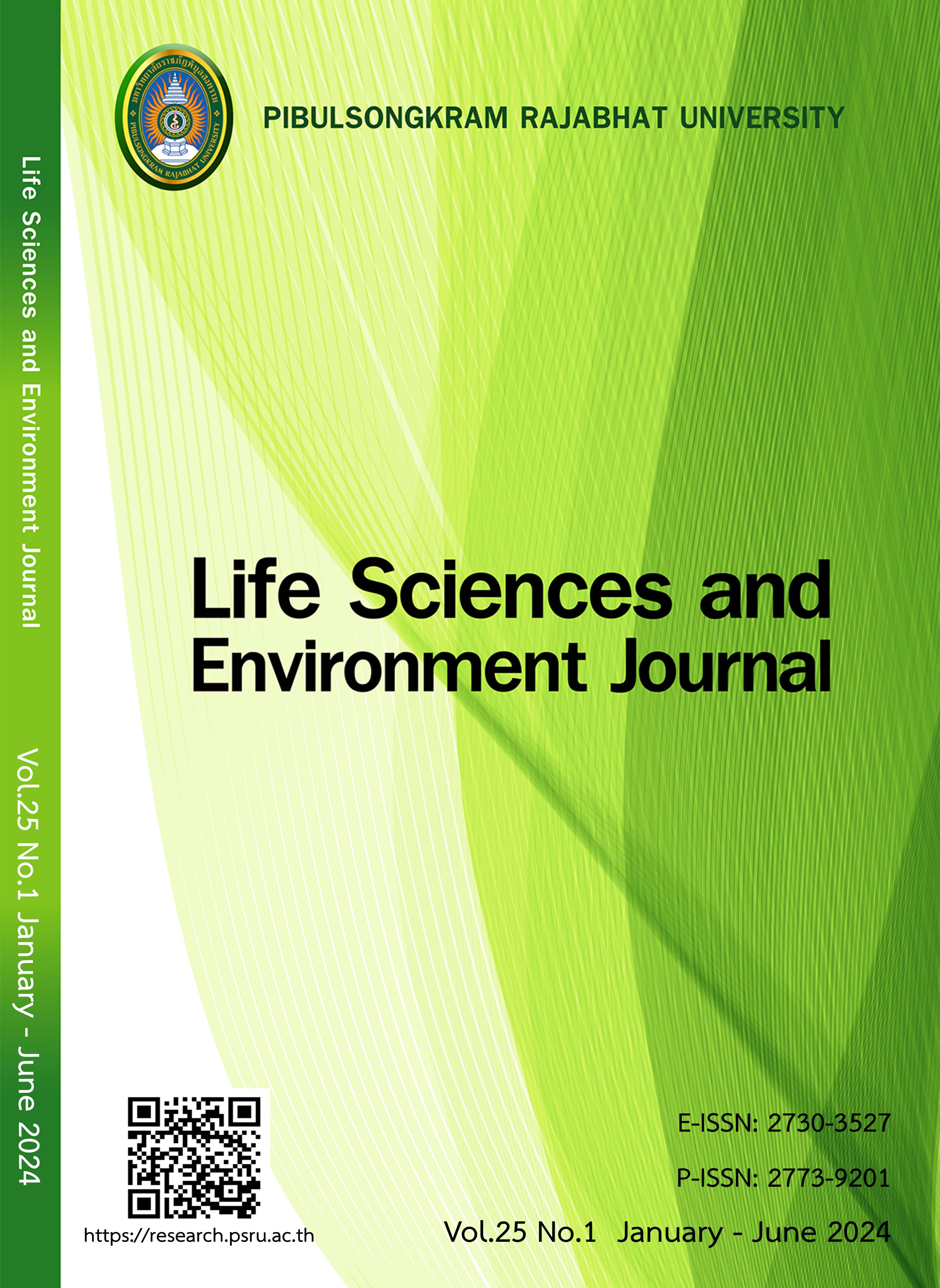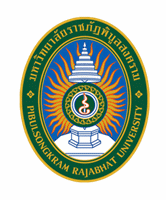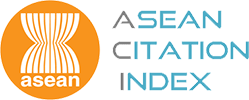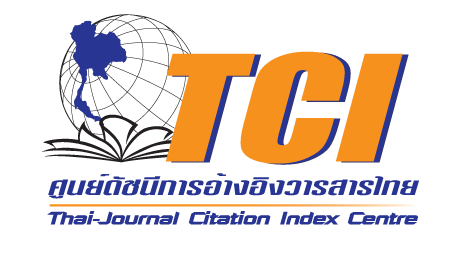ผลกระทบของอุณหภูมิที่มีต่ออัตราการทำแห้ง สารพฤกษเคมี และฤทธิ์ต้านออกซิเดชันในผลไข่เน่า
DOI:
https://doi.org/10.14456/lsej.2024.9คำสำคัญ:
ผลไข่เน่า , สารประกอบฟีนอลิก , แอนโทไซยานิน , ฤทธิ์ต้านออกซิเดชันบทคัดย่อ
งานวิจัยนี้มีวัตถุประสงค์เพื่อศึกษาอุณหภูมิที่เหมาะสมในการอบแห้งผลไข่เน่า โดยพิจารณาจากอัตราการทำแห้ง ปริมาณสารพฤกษเคมีและฤทธิ์ต้านออกซิเดชันของผลไข่เน่าอบแห้ง กำหนดอุณหภูมิในการอบแห้งที่ 45, 55 และ 65 องศาเซลเซียส นาน 15 ชั่วโมง เก็บตัวอย่างเพื่อวิเคราะห์อัตราการทำแห้งทุก 1 ชั่วโมง ใน 5 ชั่วโมงแรก และเก็บตัวอย่างทุก 2 ชั่วโมง จนถึงชั่วโมงที่ 15 ผลการทดลองพบว่า การอบแห้งผลไข่เน่าทุกอุณหภูมิมีอัตราส่วนความชื้นลดลงอย่างรวดเร็วในชั่วโมงที่ 1 ถึง 5 การอบแห้งที่ 65 องศาเซลเซียส นาน 5 ชั่วโมง มีอัตราการทำแห้งสูงที่สุดเท่ากับ 11.64 ±0.01 กรัมของน้ำต่อกรัมตัวอย่างแห้งต่อชั่วโมง (P³0.05) อัตราการอบแห้งของผลไข่เน่าทั้งสามอุณหภูมิที่เวลา
15 ชั่วโมง มีค่าระหว่าง 3.33±0.01 ถึง 5.30±0.09 กรัมของน้ำต่อกรัมตัวอย่างแห้งต่อชั่วโมง ปริมาณสารประกอบฟีนอลิกของผลไข่เน่าอบแห้งที่ 45, 55 และ 65 องศาเซลเซียส มีค่าใกล้เคียงกันระหว่าง 291.92±13.87 ถึง 313.39±24.90 มิลลิกรัมสมมูลกรดแกลลิกต่อกรัมตัวอย่างแห้ง (P<0.05) ผลไข่เน่าอบแห้ง 65 องศาเซลเซียส มีแอนโทไซยานินมากที่สุดเท่ากับ 371.21±16.26 ไมโครกรัมสมมูลของ ไซยานิดิน-3-กลูโคไซด์ต่อกรัมตัวอย่างแห้ง การทดสอบฤทธิ์ต้านออกซิเดชันผลไข่เน่าอบแห้งทุกอุณหภูมิด้วยวิธี DPPH และ FRAP มีค่าใกล้เคียงกัน (P<0.05) ระหว่าง 80.47±0.08 ถึง 80.64±0.05 มิลลิกรัมกรดแอสคอร์บิกต่อกรัมตัวอย่างแห้ง และ 7.21±0.16 ถึง 8.32±0.30 ไมโครกรัมสมมูลโทรลอกซ์ต่อกรัมตัวอย่างแห้ง ตามลำดับ อย่างไรก็ตาม ผลไข่เน่าอบแห้งที่ 65 องศาเซลเซียส มีฤทธิ์ต้านออกซิเดชันด้วยวิธี ABTS ต่ำที่สุด (P³0.05)
References
Ajiboye TO. Standardized extract of Vitex doniana Sweet stalls protein oxidation, lipid peroxidation and DNA fragmention in acetaminophen-induced hepatotoxicity. Journal of Ethnopharmacology 2015;164:273-282.
Berk Z. Food Process Engineering and Technology. 3rd ed. Cambridge: Academic Press; 2018.
Burton-Freeman B, Sandhu A, Edirisinghe I. Anthocyanins. In Gupta RC. (Ed.), Nutraceuticals: Efficacy, Safety and Toxicity. Cambridge: Academic Press; 2016:489-500.
Chaiprasop O. Food Preservation: FDT 3205. 3rd ed. Bangkok: Ramkhamhaeng University Press; 2015.
Chaovanalikit A. Extraction and analysis of anthocyanin. Srinakharinwirot University Journal of Sciences and Technology 2011;3(6):26-36.
Charmongkolpradit S, Somboon T, Phatchana R, Sang-aroon W, Tanwanichkul B. Influence of drying temperature on anthocyanin and moisture contents in purple waxy corn kernel using a tunnel dryer. Case Studies in Thermal Engineering 2021;25:100886.
Chouhan HS, Sridevi K, Singh NK, Singh SK. Anti-inflammatory activity of ethanol extract of Vitex glabrata leaves. Pakistan Journal of Pharmaceutical Sciences 2012;25(1):131-134.
ElGamal R, Song C, Rayan AM, Liu C, Al-Rejaie S, ElMasry G. Thermal degradation of bioactive compounds during drying process of horticultural and agronomic products: a comprehensive overview. Agronomy 2023;13:1580.
Francavilla A, Joye IJ. Anthocyanins in whole grain cereals and their potential effect on health. Nutrients 2020;12:2922.
Giusti MM, Wrolstad RE. Characterization and measurement of anthocyanins by UV-Visible spectroscopy. Current protocols in food analytical chemistry. (2001). F1.2.1- F1.2.13
Halee A, Rattanapun B. Study of antioxidant efficacies of 15 local herbs. KMUTT Research & Development Journal 2017;40(2):283-294.
Hu D, Wei L, Liao W. Brassinosteroids in Plants: Crosstalk with Small-Molecule Compounds. Biomolecules 2021;11(12):1800.
Ilyasov IR, Beloborodov VL, Selivanova IA, Terekhov RP. ABTS/PP decolorization assay of antioxidant capacity reaction pathways. International Journal of Molecular Sciences 2020;21(3):1131.
Intarasam S, Meemin T, Kongsema M, Pradermwong K. Cell viability enhancing and cellular protection activity of Vitex glabrata R.Br. crude fruits extract on TK6 and L929 cell lines. Thai Journal of Pharmaceutical Sciences 2020;44(4):220-228.
Jahangiri Y, Ghahremani H, Abedini TJ, Ataye SA. Effect of temperature and solvent on the total phenolic compounds extraction from leaves of Ficus carica. Journal Chemistry Pharmaceutical 2011; 3(5):253-259.
Kamphaengphet Rajabhat University. Vitex glabrata. 2023. Available at: https://www.doa.go.th/hort/? page_id=52398. Accessed December 15, 2023.
Khoo HE, Azlan A, Tang ST, Lim SM. Anthocyanidins and anthocyanins: colored pigments as food, pharmaceutical ingredients, and the potential health benefits. Food & Nutrition Research 2017; 61(1):1361779.
Kumboonma P, Sombatsri S. Antioxidant activities and total phenolic contents from Thai wild fruits. KKU Science Journal 2019;47:34-42.
Matthayom W, Nochai K, KoKaew K, Pisapak K, Robmuang D. Investigation of antioxidant capacity and antioxidant activity of Ma-huad (Lepisanthes rubiginosa (Roxb.) Leenh.) juice. RMUTSB Academic Journal 2020;8(2):187-198.
Oancea S. A Review of the current knowledge of thermal stability of anthocyanins and approaches to their stabilization to heat. Antioxidants (Basel) 2021;10(9):1337.
Patrón-Vázquez J, Baas-Dzul L, Medina-Torres N, Ayora-Talavera T, Sánchez-Contreras A, García-Cruz U, et al. The effect of drying temperature on the phenolic content and functional behavior of flours obtained from lemon wastes. Agronomy 2019;9:474.
Ponder A, Hallmann E, Kwolek M, Srednicka-Tober D, Kazimierczak R. Genetic differentiation in antho-cyanin content among berry fruits. Current Issues in Molecular Biology 2021;43(1):36-51.
Promnikorn K, Jutamaneea K, Kraichak E. MaxEnt model for predicting potential distribution of Vitex glabrata R.Br. in Thailand. Agriculture and Natural Resources 2019;53:44-48.
Rahman Md Z, Hasanuzzaman Md. Solar drying system. In Hasanuzzaman Md. (Ed.), Technologies for solar thermal energy: Theory, design, and optimization. Cambridge: Academic Press;2022:237-266.
Rongsuphan T, Kajorncheappunngam S. Anthocyanin content, antibacterial activity, and antioxidant capacity of purple corn cob extract via ultrasonic extraction. Phranakhon Rajabhat Research Journal (Science and Technology) 2019;14(1):47-61.
Technologychaoban. (2022). Vitex glabrata. 2023. Available at: 2023. Available at: https://www.doa. go.th /hort/?page_id=52398. Accessed December 15, 2023.
Thengyai S, Thiantongin P, Sontimuang C, Ovatlarnporn C, Puttarak P. α-Glucosidase and α-amylase inhibitory activities of medicinal plants in Thai antidiabetic recipes and bioactive compounds from Vitex glabrata R. Br. stem bark. Journal of Herbal Medicine 2020;19:100302.
Thaiwong N, Kongin S, Angajchariya A, Kachenpukdee N. Suitable temperature and combined pretreatment methods on quality of Caulerpa Lentillifera. YRU Journal of Science and Technology 2023;7(1):66-74.
Thaiwong N, Buaphet D, Kachenpukdee N. Bioaccessibility of Sea Grape (Caulerpa lentillifera) in simulated human digestive system in vitro Digestion Model. The Journal of KMUTNB 2022;32(4): 966-977.
Zhao D, Wei J, Hao J, Han X, Ding S, Yang L, Zhang Z. Effect of sodium carbonate solution pretreatment on drying kinetics, antioxidant capacity changes, and final quality of wolfberry (Lycium barbarum) during drying. LWT—Food Science and Technology 2019;99:254-261.
Zhong Y, Shahidi F. Methods for the assessment of antioxidant activity in foods. In Shahidi F. (Ed.), Handbook of Antioxidants for Food Preservation. Cambridge: Woodhead Publishing; 2015:287-333.
Downloads
เผยแพร่แล้ว
How to Cite
ฉบับ
บท
License
Copyright (c) 2024 Life Sciences and Environment Journal

This work is licensed under a Creative Commons Attribution-NonCommercial-NoDerivatives 4.0 International License.
Each article is copyrighted © by its author(s) and is published under license from the author(s).









